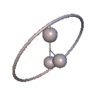Track cone and pole cone
The track cone and the Polkegel are centrifugal theory surfaces from the axis of rotation of a gyroscope be bypassed with base in the space or in the gyro. In the symmetrical Euler gyro, or more generally in the regular precession , the cones are shaped like geometric circular cones , which is generally not the case. The track and pole cones can be designed as desired, open or discontinuous, see also the animations below. The lane bowling is also Rastpolkegel or herpolhode cone and Polkegel also Gangpolkegel or polhode cone called (from ancient Greek πόλος Polos , "axis", ὁδός Hodos , "way street" and ἕρπω hérpo , "creep").
Pendulum motion of a Goryachev-Chaplygin top
The line of contact between the track cone and pole cone is the momentary axis of rotation on which all points of the cone are momentarily stationary. Every movement of the top with a fixed point can therefore be interpreted as the rolling of the pole cone fixed to the body on the spatially fixed track cone.
Instead of the track cone and pole cone, the path line of the end point of the angular velocity contained in them can also be considered. The resulting track or pole curves also roll off one another without sliding . The distance between the support point and the common point of the two curves also shows the speed of the rolling process.
Be exploited technically track and Polkegel the curve centrifugal and Koller mills and roller mills.
See also
- Poinsot construction with polhodes and herpolhodes, which correspond to the pole or track curve.
- Rastpolbahn and Gangpolbahn , which roll on each other at the momentary pole , which is the location of its axis of rotation in a plane movement of a rigid body .
literature
- K. Magnus : Kreisel: Theory and Applications . Springer, 1971, ISBN 978-3-642-52163-8 , pp. 27 f . ( Limited preview in Google Book Search [accessed February 20, 2018]).
- R. Grammel : The top . Its theory and its applications. Vieweg Verlag, Braunschweig 1920, DNB 451641280 , p. 39 ( archive.org - "swing" means angular momentum and "torsional balance" means rotational energy).

